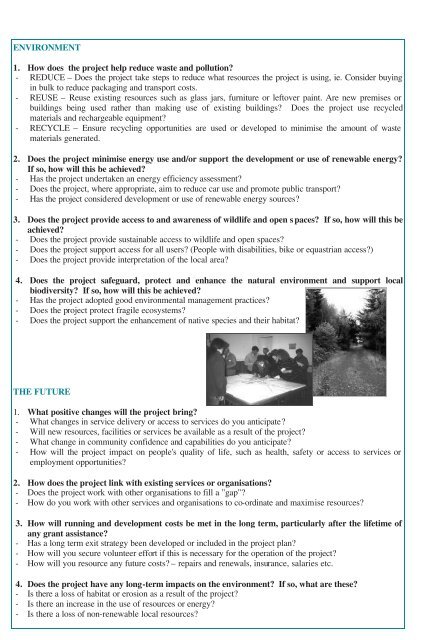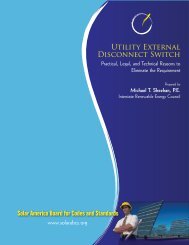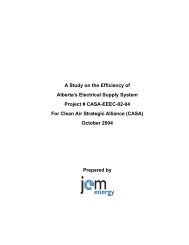A Practical Guide to Creating a Sustainable Community Building
A Practical Guide to Creating a Sustainable Community Building
A Practical Guide to Creating a Sustainable Community Building
You also want an ePaper? Increase the reach of your titles
YUMPU automatically turns print PDFs into web optimized ePapers that Google loves.
ENVIRONMENT1. How does the project help reduce waste and pollution?- REDUCE – Does the project take steps <strong>to</strong> reduce what resources the project is using, ie. Consider buyingin bulk <strong>to</strong> reduce packaging and transport costs.- REUSE – Reuse existing resources such as glass jars, furniture or lef<strong>to</strong>ver paint. Are new premises orbuildings being used rather than making use of existing buildings? Does the project use recycledmaterials and rechargeable equipment?- RECYCLE – Ensure recycling opportunities are used or developed <strong>to</strong> minimise the amount of wastematerials generated.2. Does the project minimise energy use and/or support the development or use of renewable energy?If so, how will this be achieved?- Has the project undertaken an energy efficiency assessment?- Does the project, where appropriate, aim <strong>to</strong> reduce car use and promote public transport?- Has the project considered development or use of renewable energy sources?3. Does the project provide access <strong>to</strong> and awareness of wildlife and open s paces? If so, how will this beachieved?- Does the project provide sustainable access <strong>to</strong> wildlife and open spaces?- Does the project support access for all users? (People with disabilities, bike or equastrian access?)- Does the project provide interpretation of the local area?4. Does the project safeguard, protect and enhance the natural environment and support localbiodiversity? If so, how will this be achieved?- Has the project adopted good environmental management practices?- Does the project protect fragile ecosystems?- Does the project support the enhancement of native species and their habitat?THE FUTURE1. What positive changes will the project bring?- What changes in service delivery or access <strong>to</strong> services do you anticipate?- Will new resources, facilities or services be available as a result of the project?- What change in community confidence and capabilities do you anticipate?- How will the project impact on people's quality of life, such as health, safety or access <strong>to</strong> services oremployment opportunities?2. How does the project link with existing services or organisations?- Does the project work with other organisations <strong>to</strong> fill a "gap"?- How do you work with other services and organisations <strong>to</strong> co-ordinate and maximise resources?3. How will running and development costs be met in the long term, particularly after the lifetime ofany grant assistance?- Has a long term exit strategy been developed or included in the project plan?- How will you secure volunteer effort if this is necessary for the operation of the project?- How will you resource any future costs? – repairs and renewals, insurance, salaries etc.4. Does the project have any long-term impacts on the environment? If so, what are these?- Is there a loss of habitat or erosion as a result of the project?- Is there an increase in the use of resources or energy?- Is there a loss of non-renewable local resources?









